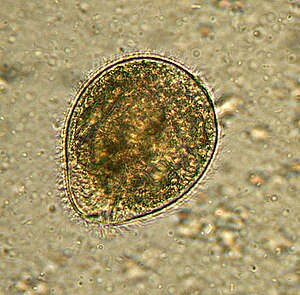Balantidium coli
| Balantidium coli | ||||||||||||
|---|---|---|---|---|---|---|---|---|---|---|---|---|

Balantidium coli |
||||||||||||
| Systematics | ||||||||||||
|
||||||||||||
| Scientific name | ||||||||||||
| Balantidium coli | ||||||||||||
| ( Malmsten , 1857) |
Balantidium coli (from Greek τὸ βαλάυτι · ου balant- "purse") is an egg-shaped, eyelash-haired type of large protozoa that occurs in the digestive tract of various animals andcan cause diarrhea and ulcers of the intestine ( balantidiasis ). It is the only ciliates that the human affects and the largest known protozoan primate attacks.
features
In the active form, Balantidium coli reaches a length of 30 to 150 by 25 to 120 µm, whereby the size varies widely and in individual cases can reach up to 200 µm. The cell mouth sits on the pointed front end, the cell juvenile on the rounded rear end. In the cytoplasm are a wiener-shaped macro nucleus and a round micronucleus . There are also mitochondria- like structures, which could be hydrogenosomes , as well as peroxisomes , endoplasmic reticulum , ribosomes and several digestive vacuoles . Two contractile vacuoles are used for osmoregulation . The locomotion happens with the help of the cilia , which set the animal in a rotating motion.
The cell division is asymmetric, wherein in each case a front and a rear cell arise newly form the cell or after cell mouth after the division. In addition, sexual reproduction occurs via conjugation , whereby the two partners connect at the cell mouths and exchange micronuclear genetic material formed by meiosis .
The round to egg-shaped cysts have a diameter of 40 to 60 µm and a thickened wall and, in contrast to active animals, are able to survive the gastric passage . The exact circumstances of the cyst formation are unknown, as no cyst formation can be observed in culture .

Bacteria and food particles that pass through the large intestine serve as food, including red blood cells in the event of severe infestation and bleeding into the digestive tract .
Pathology and therapy
The host spectrum of Balantidium coli is very broad and ranges from coelenterates and crustaceans to various mammals , especially pigs . The species belongs to the infusoria and is distributed worldwide. In most hosts, infestation does not cause symptoms of disease. Humans are rarely attacked.
The cysts are ingested through contaminated food or water, develop into active trophozoites in the intestine and form bottle-shaped lesions in the submucosa between the mucous membrane and muscle tissue of the large intestine, in which they form so-called nests. Cysts and active cells are excreted in the feces. B. coli does not form any known poisons, but the infestation can lead to the formation of large intestinal ulcers in humans and other primates, which is triggered by the formation of hyaluronidase , which dissolves the hyaluronic acid in the connective tissue . Serious illnesses are accompanied by bloody stool, obsession with bowel movements and weight loss and can be fatal in individual cases, but are rare. The disease can be treated with tetracyclines (e.g. doxycycline ) or metronidazole . Hygiene, especially when dealing with pigs in warmer climates, provides good protection against infection.
literature
- E. Auerbach: A study of Balantidium coli Stein 1863, in relation to cytology and behavior in culture. In: Journal of Morphology . tape 93 , no. 3 , 1953, pp. 405-445 (English).
- FL Schuster, L. Ramirez-Avila: Current World Status of Balantidium coli . In: Clinical Microbiology Reviews . tape 21 , no. 4 , 2008, p. 626-638 (English).
Web links
- Path of the disease at cdc.gov (English)
Individual evidence
- ^ Marianne Abele-Horn: Antimicrobial Therapy. Decision support for the treatment and prophylaxis of infectious diseases. With the collaboration of Werner Heinz, Hartwig Klinker, Johann Schurz and August Stich, 2nd, revised and expanded edition. Peter Wiehl, Marburg 2009, ISBN 978-3-927219-14-4 , p. 290.
